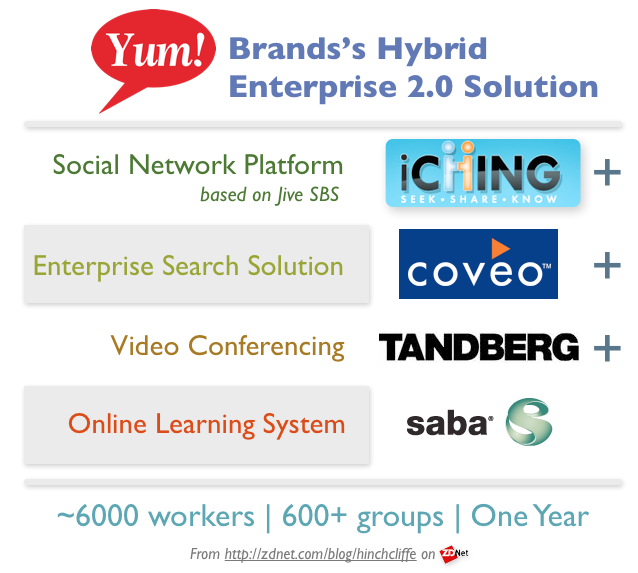Enterprise 2.0 success: Yum! Brands

Taking us half way way through our ten part series on large companies realizing enterprise social media -- please read the overview here -- we queue up our next example. In the last post, we took a close look at the story of the global chemical firm BASF and the outcome of its carefully planned internal social networking effort. In the next case study we take a look at what convenience foods conglomerate Yum! Brands has accomplished with its social collaboration initiative.
While Yum! Brands itself isn't necessarily a household name, its three top brands -- Taco Bell, KFC, and Pizza Hut -- are instantly recognizable around the world. The international fast food giant is truly global with over 330,000 workers in 110 countries with a combined annual revenue in excess of $11 billion.
Starting several years ago, the company realized it had significant challenges in being highly geographically distributed. Such dispersion created silos of knowledge and know-how, something that is potentially disastrous in the highly competitive industry of food service. For example, new ideas -- especially targeted ones for emerging markets -- needed to quickly make their way from remote countries that understood the local culture well to corporate headquarters in Louisville. Expertise and support needed to flow back into the field, but a diverse workforce and rapidly changing markets created a real challenge in connecting the right internal talent together at the right time.
The brainchild of the Vice President of IT, Dickie Oliver, Yum! ended up crafting a multi-point strategy for improving worker collaboration within company management and administration, a 6,000 worker capability in the back office of the company that kept its global operations working smoothly. The first -- and primary -- element of the collaboration strategy consisted of a social networking platform dubbed iCHING that could be used to forge Facebook-style connections between workers, generate a flow of information based on the news feed/activity stream model, as well as features for working together on and sharing documents and other important work artifacts. Perhaps most vitally, workers could also pose questions to the social network and tap into expertise around the company.
The second plank of the collaboration strategy was the use of a cross-silo search engine from Coveo. I've previously explored how discovery and a good intranet search strategy is essential to get much of the long term ROI from the valuable corporate knowledge which accumulates in social environments. This element of the internal social business strategy was aimed at this issue. Coveo was used to connect various information types both inside the social network and across the company to create a seamless discovery experience that leverages the SEO power of the corporate link ecosystem, which is especially effective as social media creates contextual relevance as users share references to other enterprise data.
The third and four planks included an HD telepresence system from Tandberg and an online training system from Saba, each aimed at collapsing the perceived distance between different offices around the world while the letter focused on making employee learning consistent, no matter the culture or language.
Based on the Jive Social Business Platform, iCHING was customized to drive specific outcomes that were important to the company. This included adding workers to upload virtual "badges" to an individual’s social profile helping transform Yum!'s "culture of recognition" to their online community. They also made tagging of work content mandatory to increase the effectiveness of search in the social network. Finally, certain important action -- such as creating new groups -- prompted users to ensure there were no similar sub-communities before creating them, reducing duplication and fragmentation of conversation.
Within six months of roll-out, over 3,600 corporate workers had joined the social network and created over 600 social groups to interact and collaboration. Thousands of documents have been uploaded for sharing and joint effort. One iCHING case study cites that, on average, a document uploaded has been downloaded 5 times, meaning that users are finding the knowledge that they need and retention of vital corporate information is actually resulting in reuse.
The intent is for iCHING to be the default work environment for corporate employees and reports indicate they have now achieved nearly 100% adoption in the back office.
Like many of the most successful Enterprise 2.0 implementations, a pro-active investment was made in "getting people to use the system" using a "combination of IT, policy and culture change." This included enlisting targeted “activation squads” at each brand to drive efforts to reach 100% adoption before the one-year mark of launch. They reach out to workers to help them understand how best to leverage iCHING's value for more efficient capture and sharing of business knowledge and improved collaboration.
Next Story: News Corp
Don’t miss a single success story. Subscribe to my blog and I’ll keep you updated with the latest case studies.
Other case studies:
- Exploring Enterprise 2.0 Success - Social Business Story #1: Alcatel-Lucent
- Social business success: CEMEX
- Social business success: Burberry
- Enterprise 2.0 success: BASF
Note: If you'd like to consider adding your organization to this list, represent a Fortune 500 or Global 2000 firm, and have publicly released your data for the first time in approximately the last 24 months, please send me your information via e-mail here.
